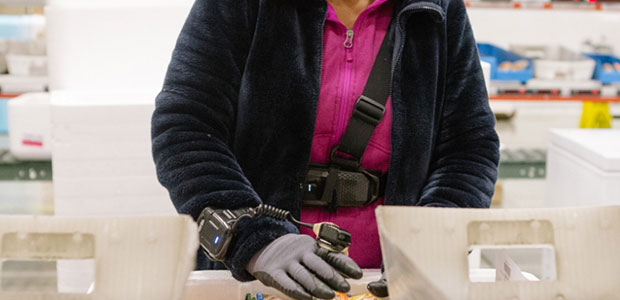
One New Device Tracks Warehouse Worker Movement to Improve Safety
A monitor device made by startup StrongArm Technologies Inc. tracks employee movement and notifies them when their activity is potentially dangerous—and it’s already helping reduce workplace injuries.
Jack Westley is one of many workers wearing the StrongArm tracker device to ensure he is doing his job as safely as possible. As a worker in a freezer warehouse, Westley’s job is treacherous. But his new piece of equipment—a black device the size of a smartphone—is a seemingly simple way to reduce his risk of workplace injury.
Working in the warehouse is a dangerous one. Westley is constantly carrying boxes, moving equipment, and bending over in cold temperatures while ice forms on his beard. Plus, risk for injury is heightened when the body is cold, according to one Bloomberg article.
The device is programmed to buzz when a wearer makes dangerous movements. For Westley, this means bending too deeply to pick up a box or twisting too far to set one down. The device on his chest vibrates as a warning that his chance of getting hurt is elevated.
And the warnings are affective, Westley said. He noticed he’d developed a habit of bending at the waist as he reached far into pallets to pull out boxes.
“That might’ve been something they would vibrate on me for, but I started walking around to the sides of pallets, you know, thanks to the reminder,” said Westley.
The device is made primarily to keep workers safe on the job. However, it sends information it gathers about Westley to his employer, Geodis. The warehouse where he works, in Breinigsville, Pennsylvania, is one of a handful of locations where Geodis is testing StrongArm devices. They are also in use at facilities operated by Walmart Inc. and other companies.
There is pushback as to the collection of information for employers, though. Unions and researchers who study workplace surveillance think that employers who gather data on workers for any reason will be unable to resist using it against them. Productivity and tracking can be used against workers to fire or punish them if their performance dips, and the opacity of data-analysis tools can make it tough for employees to understand how this data is being used.
However, the other side of the coin suggests that devices like these with information collection can actually help and encourage workers to be safer on the job. Goedis says the trackers could supplement existing safety programs by noting employees who need extra coaching, while also helping single out locations in its operations that could be redesigned to reduce the risk of injury.
StrongArms is aware of the potential negatives of an information-tracking device like this one, but it emphasizes that its mission is to protect workers first and foremost. A recent study found that users of the device suffer 20 to 50 percent fewer injuries than those who do not. StrongArm also notes that it is not tracking individual productivity, and its products aren’t used to punish individual workers or contest worker compensation claims. Goedis also uses different measurement systems, not including the StrongArm device, to track worker productivity and incentivize.
To read more about the founder of Strong Arm, Sean Petterson, and his story, read the Bloomberg article. He has been exposed to the safety industry most of his life, and he always dreamed of inventing technologies to help safety workers do their jobs safer.
The science behind devices like this one—called ergonomic tracking—is a growing field of innovation. Researchers hope to continue developing ergonomic tracking to best marry efficiency with safety using more data and technology. However, there is still a line in the industry between data collection and personal comfort that could potential cross emotional boundaries for some employees.
Nevertheless, the StrongArm device has already helped workers avoid injury, and the company hopes to reach more employees around the U.S. in the future. Employers should always prioritize worker safety, and personal movement trackers like this one might be a crucial way to do so.